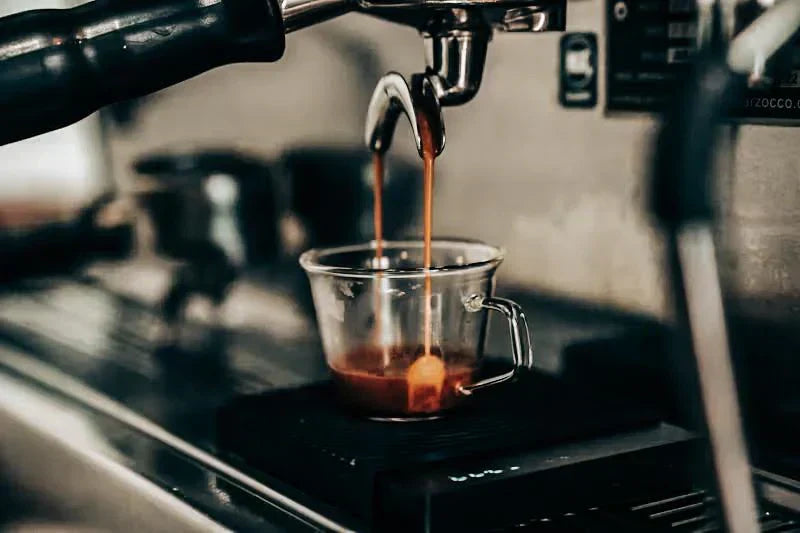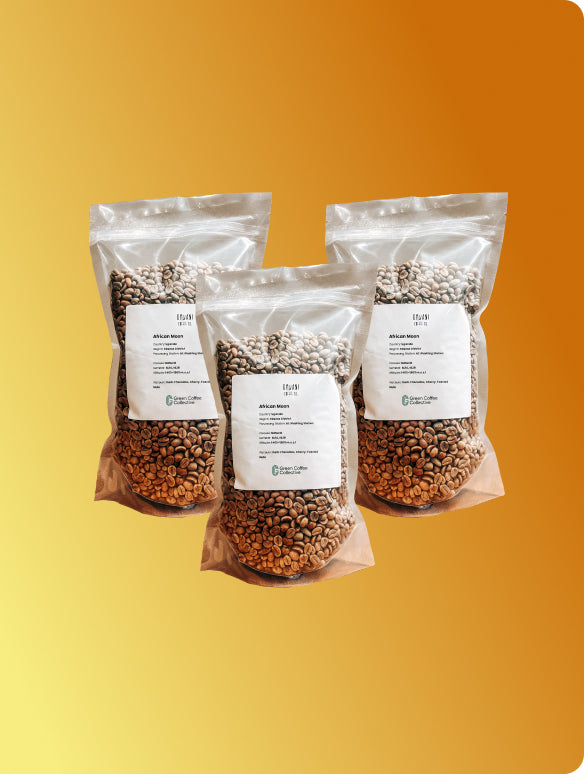Introduction
Espresso Brewing at home? The right green coffee beans make all the difference.
Whether you're a seasoned home roaster, a professional, or a boutique wholesaler, the journey to a great espresso begins long before the machine; it starts with the right green coffee beans. For espresso brewing, bean selection plays a pivotal role in shaping the flavour profile: body, crema, acidity, and sweetness all depend on the origin, process, and roast potential of the green coffee you choose.
With espresso’s rising popularity across home kitchens and speciality cafés in the UK and Europe, more roasters are seeking out green beans that deliver precision and depth in the cup. This guide helps you explore green coffee beans specifically suited for espresso, curated for their balance, density, and potential to shine under pressure.
Let’s find the perfect green coffee bean to craft bold, complex, and delicious espresso; your way.
What is Espresso Brewing, and Why Is It So Popular?
Espresso brewing is a concentrated coffee-making method that forces hot water through finely ground coffee at high pressure. The result? A small, rich, and intense shot of coffee topped with a signature golden crema. It’s fast, bold, and full of character, making it a favorite for both traditionalists and modern speciality coffee lovers.
The appeal of espresso lies in its depth and efficiency. In under 30 seconds, it delivers a powerful burst of flavor, whether enjoyed straight or as the foundation for drinks like cappuccinos, lattes, or flat whites.
Born in early 20th-century Italy, espresso was originally developed as a way to serve coffee quickly in bustling cafés. The name itself means "pressed out" in Italian, a nod to the pressurized extraction method. Over time, it became a global symbol of coffee culture, especially across Europe.
Espresso typically produces a bold, full-bodied flavour with low acidity, dense sweetness, and a velvety texture, qualities that come alive when paired with the right green coffee beans.
This guide will help you explore how to select green coffee beans ideal for espresso, understand their distinct traits, and appreciate how the brewing process brings out their best.
Step-by-Step Espresso Brewing Guide
Mastering espresso brewing requires precision, consistency, and an understanding of how each element, from grind size to water quality, affects your shot. Below is a step-by-step guide to help you get the most out of your green coffee beans once roasted.
Step 1: Grind Size
For espresso, use a very fine grind, almost like powdered sugar. The finer the grind, the more surface area water can contact, essential for proper extraction under high pressure.
Step 2: Water Temperature
Aim for a water temperature between 90–96°C (195–205°F). Too hot, and your coffee may taste burnt or overly bitter; too cool, and you'll under-extract, leading to sour or flat notes.
Step 3: Water Quality
Use filtered water with balanced mineral content. Water that's too soft or too hard can distort flavour and damage equipment over time. Great espresso starts with clean, consistent water.
Step 4: Bean-to-Water Ratio
A common recommendation is a 1:2 ratio, for example, 18g of coffee yielding 36g of espresso. This can be adjusted depending on roast level and desired strength.
Step 5: Brewing Process
- Weigh your dose: Use a scale to measure your dry dose (e.g., 18–20g for a double shot).
- Grind freshly: Just before brewing, grind your roasted green beans finely and evenly.
- Distribute and tamp: Ensure the grounds are evenly distributed, then tamp with consistent pressure (approx. 30 lbs).
- Start extraction: Insert the portafilter and begin the shot. A good espresso shot should take 25–30 seconds.
- Monitor yield: Stop extraction when your target output is reached.
Step 6: Troubleshooting Common Issues
- Sour taste / too sharp: Under-extracted. Try a finer grind or higher temperature.
- Bitter/harsh: Over-extracted. Use a coarser grind or reduce brew time.
- Shot runs too fast: Grind is too coarse or tamp is too light.
- Shot drips slowly: Grind is too fine or tamp is too heavy.
By adjusting these variables and choosing high-quality green coffee beans, you’ll refine your espresso brewing process with every shot.
Equipment You’ll Need for Espresso Brewing
-
Espresso Machine
A reliable machine capable of maintaining stable pressure and temperature is essential for proper extraction. -
Portafilter & Basket
Comes with your espresso machine, choose the right basket size (single, double) based on your dose. -
Burr Grinder (Espresso-Grade)
A high-quality burr grinder allows you to achieve the very fine and consistent grind needed for espresso. -
Tamper
A flat, well-fitted tamper ensures even compression of coffee grounds for balanced extraction. -
Filtered Water Supply
Use a water filter or bottled water with balanced mineral content to avoid off-flavors and machine damage. -
Temperature-Controlled Kettle (Optional for Some Machines)
Some machines include built-in boilers, but for manual preheating or cleaning, a kettle with temperature control helps maintain consistency. -
Precision Scale
Weighing your dose and yield ensures repeatability and helps fine-tune your espresso recipes. -
Timer (Built-in or External)
Track shot times to identify over- or under-extraction and stay consistent with your brewing parameters.
Each of these tools supports accuracy, quality, and control, especially when working with freshly roasted green coffee beans tailored for espresso.
Why the Right Green Coffee Beans Matter for Espresso Brewing
Selecting the right green coffee beans is foundational to achieving exceptional espresso. Because espresso uses pressure and speed to extract flavor, the bean’s inherent qualities must align with the brewing method to deliver the best possible result.
-
Flavour Optimisation
Espresso emphasises richness, sweetness, and intensity. Choosing green beans with chocolatey, nutty, or fruity undertones helps highlight those characteristics during roasting and brewing. -
Grind Compatibility
For espresso’s fine grind, bean density and moisture content are crucial. Denser or higher-moisture beans may require grind adjustments to avoid uneven extraction or channeling. -
Roast Suitability
Not every green coffee can withstand darker roasting without losing balance. Beans with higher sugar content and lower acidity tend to perform better when roasted for espresso’s concentrated format. -
Body & Acidity Balance
Espresso demands a cup with structure and depth. Beans with fuller body and moderate acidity create a smooth, balanced shot without sharpness or hollowness. -
Brewing Efficiency
Since espresso brewing is fast, the bean must release its soluble compounds quickly. Some origins and processing methods support this rapid extraction better than others. -
Personalisation
Roasters who choose based on origin, varietal, and process gain greater control over how the final espresso tastes. Whether you're after syrupy sweetness or vibrant fruit, the right green coffee bean makes it possible.
In short, for espresso brewing, bean selection isn’t optional; it’s essential. It’s where great espresso starts.
Key Traits of Ideal Beans for Espresso Brewing
When selecting green coffee beans for espresso, certain traits make a big difference in cup quality, roast behaviour, and extraction efficiency. Understanding these traits helps you choose beans that align with the unique demands of espresso brewing.
-
Origin Examples
While origins like Ethiopia and Kenya are often prized for complex acidity, not all are ideal for espresso. For a balanced, syrupy shot, consider: - Brazil: Known for nutty, chocolatey profiles and low acidity, perfect for a smooth espresso base.
- Colombia: Offers versatility with caramel sweetness and gentle fruit notes.
- Processing Method
- Roast Level
- Pre-Roast Considerations: Choose beans that tolerate medium to dark roasting without collapsing in flavour.
- Post-Roast Recommendation: A medium-dark roast often works best for espresso, promoting solubility and body while maintaining sweetness.
-
Flavour Profile
Espresso benefits from bold, well-structured profiles. Look for beans with: - Caramel, cocoa, and nutty base notes for warmth and balance.
- Stone fruit, berry, or dried fruit accents to add sweetness and complexity.
- Moderate acidity and dense mouthfeel to support a smooth, lingering finish.
Choosing green coffee beans with these traits ensures that once roasted, they’ll perform beautifully under pressure, literally, producing espresso that’s layered, expressive, and satisfying.
Tips for Roasting & Brewing with Espresso Brewing
-
Roasting Tip
For espresso-focused green coffee beans, aim for a full city to full city+ roast. This range helps enhance body, reduce sharp acidity, and bring forward deeper notes like caramel, chocolate, and dried fruit. Keep development time steady to ensure solubility and even extraction without tipping into harshness or smokiness. -
Brewing Tip
Always distribute grounds evenly and tamp with consistent pressure. Uneven distribution or an inconsistent tamp can cause channeling, leading to sour or bitter notes in your espresso shot. -
Equipment Suggestion
A precision burr grinder designed for espresso is essential. It allows for fine adjustments to dial in your grind size and ensures uniform particles, which is critical for consistent, balanced extractions.
By aligning your roast level and brew technique with espresso’s specific needs, you unlock the full potential of your carefully selected green coffee beans, shot after shot.
Mistakes to Avoid When Brewing Espresso
-
Using the Wrong Grind
A grind that’s too coarse will result in under-extraction, producing a weak, sour shot. Too fine, and you risk over-extraction with harsh, bitter flavors. Espresso demands a precise, very fine grind for proper pressure and flow. -
Overheating Water
Water above 96°C (205°F) can scorch the coffee, leading to a burnt or overly bitter taste. Stick to the optimal temperature range to preserve the bean’s natural sweetness and balance. -
Using Roasted Beans by Mistake
Always start with unroasted green coffee beans. Accidentally brewing with roasted beans before controlling the roast yourself eliminates the opportunity to shape the flavour for espresso. Roasting is where the transformation begins, and it's a step you don’t want to skip.
Our Handpicked Green Coffee Beans for Espresso Brewing
Explore our hand-picked green coffee beans, each chosen for its exceptional performance with Espresso Brewing.
Brazil Green Coffee Beans – Classic Espresso Foundation
- Origin: Brazil
- Tasting Notes: Chocolate, roasted nuts, subtle dried fruit
- Suggested Roast: Full City
- Brewing Suitability: Smooth extraction, low acidity, excellent crema
- Best for: Beginners seeking a forgiving, balanced bean for everyday espresso.
Colombia Green Coffee Beans – Rich & Versatile
- Origin: Colombia (Medellín region)
- Tasting Notes: Caramel, red apple, toffee
- Suggested Roast: Medium-Dark
- Brewing Suitability: Versatile with both straight shots and milk-based drinks
- Best for: All-purpose espresso lovers wanting a balance of body and brightness.
Ethiopia Green Coffee Beans – Fruit-Forward Complexity
- Origin: Ethiopia (Guji zone)
- Tasting Notes: Blueberry, cocoa, floral undertones
- Suggested Roast: Medium to Medium-Dark
- Brewing Suitability: Bright, aromatic, high sweetness
- Best for: Advanced roasters looking to highlight fruity complexity in espresso.
Guatemala Green Coffee Beans – Balanced & Crisp
- Origin: Guatemala
- Tasting Notes: Milk chocolate, citrus zest, almond
- Suggested Roast: Medium-Dark
- Brewing Suitability: Clean, bright, and structured for single-origin shots
- Best for: Clean profile enthusiasts who enjoy citrus brightness with creamy texture.
Conclusion
Craft Espresso with Intention
Brewing exceptional espresso starts with intentional choices, and it all begins with selecting the right green coffee beans. From origin to processing method and roast potential, every variable shapes your final shot. Combined with a precise technique, these choices unlock the bold, rich, and layered flavors that define quality espresso.
Whether you're new to home roasting or refining your café’s espresso menu, don’t be afraid to experiment, adjust, and explore. The journey is part of the craft, and your perfect espresso is just a roast away.
Ready to elevate your Espresso Brewing?
Shop our curated green coffee beans for espresso or explore our full espresso brewing equipment to start building your perfect shot from the ground up.

